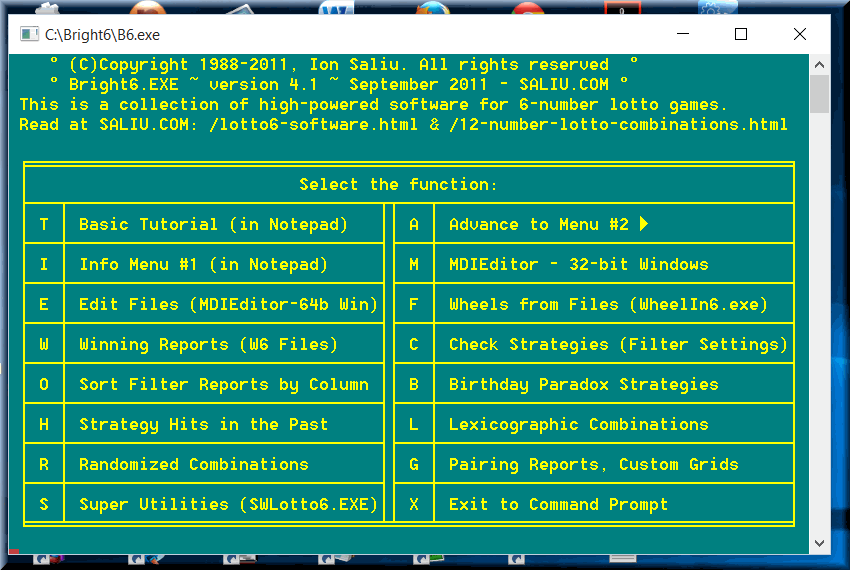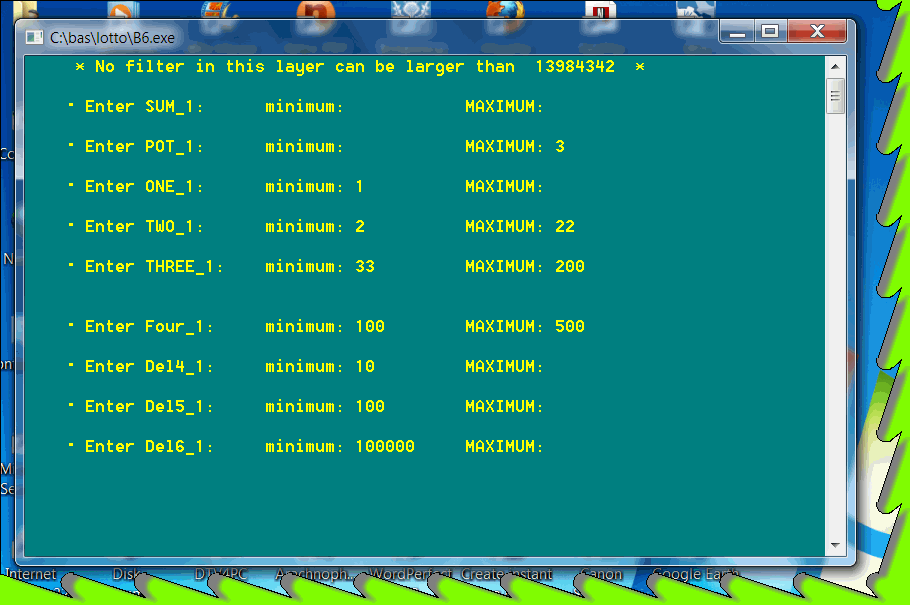
Essentials of Filtering, Filters in Lottery, Lotto Software: Reduction, Elimination of Combinations
By Ion Saliu, ★ Founder of Lottery Filter Science



Posted on May 21, 2000; later updates.
• Indeed, there is the need to present more facts on the filters in LotWon lottery software. The documentation in SuperPower$ 95 does not cover how to use the maximum values of the filters.
The latest software for all lottery and lotto games is known as Bright. It is far more powerful and much better documented.

You can see the levels of the filters for past lotto drawings by running function W = Winning Reports (W6 Files). There are several screens to input the lotto filters. You select your lotto strategy first based on the W reports. Then, you enter the lotto filter values at the corresponding screen prompts.

The minimum value of a lotto filter is equivalent to 'at least'. If we choose MAX_Two-1 = 3, we'll be correct if MAX_Two-1 was at least 3 (shown in the W6 files). That means, 3, 4, 5,…, 10, 11, etc. We would be losing if MAX_Two-1 was 2, or 1, or 0.
The maximum value of a lottery filter is equivalent to 'no more than but not equal to'. If we choose “Max_Two-1” = 3, we'll be correct if MAX_Two-1 was no more than 2. Pay special attention to this: the maximum must be at least 'the minimum plus 1'. We would be correct if MAX_Two-1 was 2, or 1, or 0 (shown in the W6 files). If MAX_Two-1 was 3 or more, that would be a losing situation.
If the W6 files shows 0 for MAX_Two-1 we can only play the maximum value for the filters. Playing the minimum value will have no effect (since it is equal to 0). In this case, the correct entry for “Max-Two-1” is 1 (0+1=1).
The effect of a filter depends on the lotto game format. I will exemplify the effect of some filters for the lotto 6/49 game. It is the most popular around the globe and I received a real-life W6 report (from the user named Guy). I will not accept any W6 files to look at any more.
1) Let's see how many combinations the minimum value of the filter Two eliminates if we set it to 1. A 6-number winning combinations can be broken down into C6 taken 2 at a time = 15 combinations. There are 49-6=43 remaining numbers. The 43 remaining numbers can be broken down into C43 taken 4 at a time = 123410 combinations of 4 numbers each. Each of the 15 2-number combinations can be attached to each of the 123410 4-number lotto combinations. The result is 15 x 123410 = 1851150 total 6-number combinations. Therefore, the filter Two = 1 eliminates 1,851,150 combinations. Let's make Two = 2. It means we eliminate all two-number combinations from the last two drawings.
If the two past drawings have no common numbers, the filter Two = 2 eliminates 1,851,150 x 2 combinations. If Two = 3, the filter should eliminate 1,851,150 x 3 combinations. And so on? NOT! In reality, some pairings (two-number combinations) are a lot more frequently than others. Some pairings do not come out even within 200 drawings. So, the effect of Two diminishes after two or three past drawings. I also recommend the use of the least 6 file: the file with the least frequent pairings in a lotto game.
If the filter Three is set to 1, it eliminates all three number lotto combinations from the most recent drawing (the previous one). C6 taken 3 at a time = 20 combinations. The 43 remaining numbers can be broken down into C43 taken 3 at a time = 12341 combinations of 3 numbers each. Each of the 20 3-number combinations can be attached to each of the 12341 3-number lottery combinations. The result is 20 x 12341 = 246820 total 6-number combinations. Therefore, the filter Three = 1 eliminates 246,820 combinations.
Let's make Three = 2. It means we eliminate all three-number combinations from the last two drawings. If the two past drawings have no common numbers, the filter Three = 2 eliminates 246,820 x 2 combinations. If Three = 3, the filter should eliminate 246,820 x 3 combinations. And so on? NOT! In reality, some three-number combinations are a lot more frequently than others. The Three lottery software filter will diminish its eliminating power after some 10 past drawings.
2) Let's see how many lotto combinations the maximum value of the filter Two LEAVES TO BE PLAYED if we set it to 1. A 6-number winning combinations can be broken down into C6 taken 2 at a time = 15 combinations. There are 49-6=43 remaining lotto numbers. The 43 remaining numbers can be broken down into C43 taken 4 at a time = 123410 combinations of 4 numbers each. Each of the 15 2-number combinations can be attached to each of the 123410 4-number combinations. The result is 15 x 123410 = 1851150 total 6-number combinations. Therefore, the lotto software filter MAX_Two = 1 LEAVES 1,851,150 combinations to be played. In other words, the software will generate 1,851,150 combinations.
Let's make MAX_Two = 2. The calculation is different now. Suppose the last two drawings have no common numbers. Thus, the last two drawings consist of 12 unique numbers. 'C12 taken 2 at a time” = 66 combinations. There are 49-12=37 remaining numbers. The 37 remaining numbers can be broken down into C37 taken 4 at a time = 66045 combinations of 4 lotto numbers each. Each of the 66 '2-number' combinations can be attached to each of the 66045 '4-number' combinations. The result is 66 x 66045 = 4358970 total 6-number combinations. Therefore, the filter MAX_Two = 2 LEAVES 4,358,970 combinations to be played.
If the lotto software filter Three is set to 1, it LEAVES TO BE PLAYED all three number combinations from the most recent drawing (the previous one). C6 taken 3 at a time = 20 lotto combinations. The 43 remaining numbers can be broken down into “C43 taken 3 at a time” = 12341 combinations of 3 numbers each. Each of the 20 '3-number' combinations can be attached to each of the 12341 3-number combinations. The result is 20 x 12341 = 246820 total 6-number combinations. Therefore, the filter Three = 1 LEAVES TO BE PLAYED 246,820 combinations.
Looking at the W6 files from Guy, I saw Two of 20 or more (the headings “2-#s”). That's a high value for the minimum value of the filters in this category (Two or 2-#s). Such a high value has corresponding high values for other filters (Three or 3-#s and “Four”). Using such high values for some filters will eliminate a huge number of combinations.
In the same reports, I saw Three filters (the headings “3-#s”) of 150 or more. Such high values for the minimum entry of Three also eliminate a huge amount of combinations.
Also, “Four” of 2000 or more (even 4000) and “Sum” of 400 or more (even 700) do eliminate millions of lotto combinations.
You will notice that high values for one filter are correlated with high values of other filters.
But these high values occur from time to time, not very frequently. You will skip some drawings in between situations of high values for the minimum level of the filters. As in Guy's reports, in drawing #20, the filter “Sum-1” was 828, then in drawing #13 it was 469. So, we played once setting “Sum-1” = 400 for the minimum level, then skipped 5 drawings and played again “Sum-1” = 400. We would have lost 2 drawings, but had another winning situation in drawing 13. Other filters would have been “Three-1” = 20 and the rest of the “3-#s” filters set to 5. All the rest of the “Sum” filters would have been at least 20. The MAX_Two-1 would have been 3, “Four = 300” and “BUN_6 = 20”.
Using such filters with WHEEL-6 lotto software will eliminate a huge number of combinations. Also, the total number of unique systems will decrease substantially. Therefore, you can stop-and-run-again the program significantly fewer times.
In reverse, efficient maximum levels of the filters are LOWER ones. For the Two filters, 0 is the most efficient value and it occurs quite frequently (more than 15 times for “2-#s–1” in 100 drawings analyzed by Guy). In such cases, you set “MAX_Two-1” = 1. There are also situations are 0. For example, you set “MAX_Two-1” = “MAX_Two-3” = 1. The effect is quite dramatic: a substantially lower number of lottery combinations will be generated. Or even more dramatically, you can set all six Two filters to me no higher than 5. Thus, “MAX_Two-1” = “MAX_Two-2” = “MAX_Two-3” =“MAX_Two-4” =“MAX_Two-5” =“MAX_Two-6” = 6.
For the lottery software filter Three, an efficient level of the maximum would be 5.
For the filter Four, you can set the minimum = 50 and MAX_Four = 100.
From all these facts, you can deduct that there are values UNUSUALLY high or UNUSUALLY low that occur from time to time in your W6 files. Therefore, we can set highly efficient filters and expect to win with substantially fewer combinations from time to time.
If you want to generate the winning combinations every time you run WHEEL-6, you need to set SAFE values for the filters. The selection of safe values is not 100% guaranteed, but it is not rocket science either. You should not expect to select the right levels of the filters every time you run the programs.
You can notice in your W6 lotto software files that usually high values are followed by lower values (or vice versa). Normally, three increases in a row are followed by a decrease (or vice versa: three decreases followed by an increase). For example, in Guy's report, Three-1 was, in three consecutive drawings, 191, 29, 12, followed by 31. I would have set Three-1 = 13 and MAX_Three-1 = 51 (an increase from 12 but no higher than 50).
Your accuracy in setting this type of safe levels of the filters will increase with usage: the more you work with the W6 files, the less erroneous your filter-setting will get.
Well, that's a lot on using the filters with Command Prompt LotWon lottery and lotto software.

Resources in Lottery, Software, Systems, Lotto Wheels, Strategies
Pages dedicated to help, instructions, filters, strategies for the best lotto programs and lottery software in the world:


